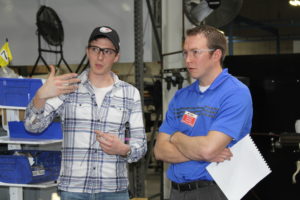 Reprinted with permission from the Winter 2017 issue of Target, an AME Publication.
Authored by Lea Tonkin
Part Four of a Four Part Series. Miss the beginning? Click Here to Read!
Reprinted with permission from the Winter 2017 issue of Target, an AME Publication.
Authored by Lea Tonkin
Part Four of a Four Part Series. Miss the beginning? Click Here to Read!
Leadership continues to hone its strategic planning process, and how strategic initiatives reflecting lean progress and goals are communicated throughout the organization. Having a three- to nine-month “thematic goal” or rallying cry, with defining objectives, has been a primary method for building alignment during the past five years. Beginning in 2017, a three-year strategic plan has been put in place to help drive longer-term decision making towards a common vision.

“Our three-year plan has helped the teams focus and continue to increase engagement,” Marc Braun said. “For example, one of our initiatives for 2017 is that every employee will spend at least a half-day learning by benchmarking at another company. We continue to improve our process for rolling forward on strategy, so that goals are aligned in five key areas: organizational health, lean/continuous improvement, revenue growth, product development and paying it forward.”
The company’s primary method for sharing strategic plans and goals with employees and asking for their feedback is the daily all-company meetings. Last year, executive committee members also asked employees also asked employees, in groups of 10-12 at a time, about their feedback on these plans, and made changes, like reducing the number of initiatives, based on feedback received.
Excellence strategy: What’s next

In the coming year, developing standard work will be a major area of focus, as Cambridge continues to drive for the next level of quality systems, according to Braun. “What’s good is that our people are asking for it,” he said. “It is employee-driven, enhancing our ability to innovate rather than stifling it. Also, using Scrum methodologies to increase the speed of product innovation through our engineering teams is a next evolution for us – using the same level of experimentation in this area, which will deliver rapid value to our clients.”
(See Scrum’s Potential for Rapid, Lean Product Development)
Cambridge is also ramping up its efforts to utilize its continuous improvement engine to build a world-class safety culture. “We have a culture that cares deeply, but intend to focus more of our continuous improvement time on building a zero-incident mindset across the company,” said Braun. “We want to be able to demonstrate that safety and innovation cultures can be built simultaneously.
“I believe lean has enabled us to grow our people faster that we’ve been able to grow our company – and at a 16 percent compounded annual revenue growth rate, that is an accomplishment our teams feel extremely proud of,” Braun said. “The desire to grow is there. Before the cultural buildout, we wouldn’t have had the ability to sustain the growth. The simplicity of the system the teams have built is that it enables others to step in and lead. We’re continuing on a journey; we’re learning, having a blast, and building a powerful, sustainable growth engine.”